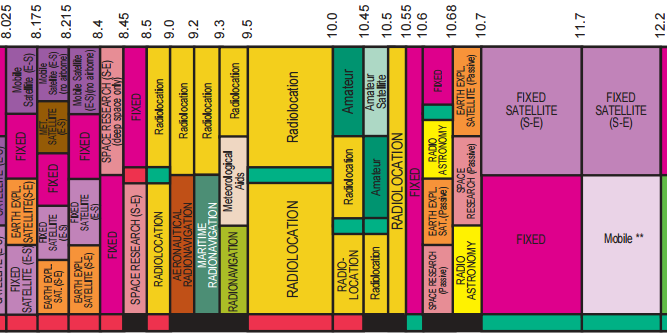How will so much data be transferred on a daily basis?
Using the X-band portion of the electromagnetic spectrum provides us with the bandwidth needed to transfer an entire high-resolution image of the earth from our satellites down to our ground stations each and every day.
What is the "X-band"?
The X-band is the portion of the electromagnetic spectrum containing the frequencies 8-12GHz [1]. X-band frequencies are contained in the Super High Frequency (SHF) portion of the electromagnetic spectrum.
Using X-band frequencies for our communications system provides us with a number of advantages [3]:
- Rain fade is an issue mainly for frequencies greater than 10GHz. X-band frequencies below 10GHz were chosen for our product, so in our case, X-band communication is more resistant to rain fade than other higher-frequency bands, such as the Ku and Ka bands. Low noise is crucial for reliable high-rate, low-noise data transfer.
- X-band performs with high power and small antennas, making it an ideal solution for fast data transfer from CubeSats.
X-Band Allocation
Allocation of the different frequencies contained in the X-band is shown in the image below.
We are using a center frequency of 8.2 GHz for our communication downlink. The allocated use for X-band frequencies in the range 8.175 GHz to 8.400 GHz is as follows [5]:
Bandwidth in the "Earth Exploration Satellites" category, the category of our our system, is allocated for non-Federal Government use. The frequency range of 8.175 GHz to 8.215 GHz supports military communications systems, but it is agreed that adjustments to the military satellite systems will be made in order to allow operation of both our system and the military's [5].
- Earth Exploration Satellites (Space-to-Earth)
- Fixed Satellites (Earth-to-Space)
- Meteorological Satellites (Earth-to-Space, limited to the range 8.175 GHz - 8.215 GHz)
- Mobile Satellites (Earth-to-Space)
Bandwidth in the "Earth Exploration Satellites" category, the category of our our system, is allocated for non-Federal Government use. The frequency range of 8.175 GHz to 8.215 GHz supports military communications systems, but it is agreed that adjustments to the military satellite systems will be made in order to allow operation of both our system and the military's [5].
Modulation Scheme
For satellite communication, transmit power is at a premium. Hence, satellite links typically have a lower CNR. Overall data rates can be transmitted at a broader bandwidth but with a lower overall CNR by using simpler modulation schemes such as QPSK and BPSK.
The modulation scheme selected and the SNR (Eb/No) together prescribe the Bit Error Rate (BER). Note that, with a 10.6 dB SNR and using Offset-QPSK (OQPSK), the resulting bit error rate (from the following graph) is 1E-7. For our spacecraft, the SNR is slightly lower, so our computed BER in further analysis in the downlink budget agrees well with this analysis.
The modulation scheme selected and the SNR (Eb/No) together prescribe the Bit Error Rate (BER). Note that, with a 10.6 dB SNR and using Offset-QPSK (OQPSK), the resulting bit error rate (from the following graph) is 1E-7. For our spacecraft, the SNR is slightly lower, so our computed BER in further analysis in the downlink budget agrees well with this analysis.
References
[1] - http://www.ntia.doc.gov/page/2011/united-states-frequency-allocation-chart
[2] - http://www.esa.int/Our_Activities/Telecommunications_Integrated_Applications/Satellite_frequency_bands
[3] - http://www.milsatmagazine.com/story.php?number=1530000863
[4] - http://www.ntia.doc.gov/files/ntia/publications/2003-allochrt.pdf
[5] - http://www.gb.nrao.edu/IPG/Interference/XBandAllocation.doc
[1] - http://www.ntia.doc.gov/page/2011/united-states-frequency-allocation-chart
[2] - http://www.esa.int/Our_Activities/Telecommunications_Integrated_Applications/Satellite_frequency_bands
[3] - http://www.milsatmagazine.com/story.php?number=1530000863
[4] - http://www.ntia.doc.gov/files/ntia/publications/2003-allochrt.pdf
[5] - http://www.gb.nrao.edu/IPG/Interference/XBandAllocation.doc



